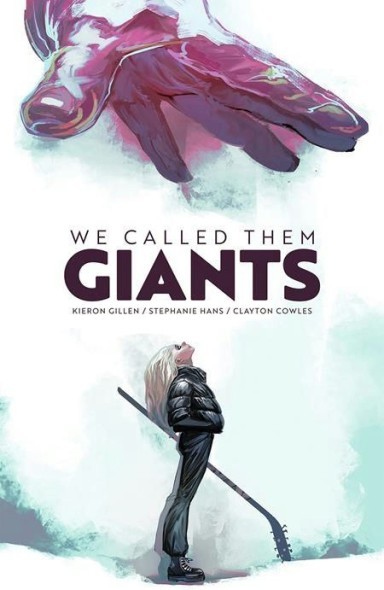Comic Books Vs. Mystery Boxes: On “We Called Them Giants”
KIeron Gillen and Stephanie Hans reteamed for this graphic novel about a very strange apocalypse.

Discussed: We Called Them Giants. Kieron Gillen, writer; Stephanie Hans; artist; Clayton Cowles, letterer; Becca Carey, designer; Image Comics, publisher.
There’s been a lot of writing this year about the 20th anniversary of the first episode of Lost. Somehow, I have seen only one episode of Lost despite the fact that it is, as the saying goes, extremely my shit; one friend compared it to a combination of The Prisoner and The X-Files, two shows I (mostly) adore. Still, there are 120 episodes of Lost that I have yet to see, and so the show’s legacy — for me — comes more from J. J. Abrams’s much-discussed concept of the “mystery box.”
Here’s the thing: for me as a reader or viewer, there are few things more stunning than a well-executed mystery box. There are also few things more infuriating than a badly-executed mystery box. I bring this up in the context of We Called Them Giants not because it’s an example of mystery box storytelling, but instead because it’s very easy to imagine what a version of this graphic novel told in the manner of a mystery box would be like. And with that in mind, I’m very glad that that isn’t the direction these creators went in when telling their story.

We Called Them Giants opens in the aftermath of, well, something. Teenager Lori has been adopted by a new family; it’s recent enough that “welcome” decorations are still on the walls. When she wakes one morning, however, she finds the rest of the family gone, as well as virtually everyone else in her neighborhood. She soon encounters Annette, one of her classmates; eventually, the two also link up with an older woman, Beatrice, who has some insights into how to survive in this radically changed landscape.
How best to describe the setting of this book? It isn’t quite post-apocalyptic; the mass disappearance has some Rapture-like elements to it, though there isn’t an overtly theological angle to it. (For that, you might want to check out 2007’s Therefore Repent!.) There are roaming gangs of people seeking to mete out violence, a gang known as the Dogs — and, given Gillen’s penchant for pop culture references, I halfway wonder if this is a nod to Pink Floyd’s Animals. But there are other threats out there as well, including the towering beings referenced in the book’s title.
There are two of them, to be specific. They arrive in the wake of the mass disappearances, and it’s unclear if they’re the cause of that event or are reacting to it. There are two of them, one red in color and one emerald. Hans does an excellent job on these designs: they’re familiar enough to feel, if not human, than somewhat recognizable, but there’s also something fundamentally alien about them, both in terms of their appearance and in terms of the language that they speak. At one point, one of them addresses Lori and his language is rendered as a long string of “blahblahblah.” Reading it, all I could think of was how the speech of adults was represented in Peanuts specials.
The last time Kieron Gillen and Stephanie Hans collaborated on a project was the series Die, about a group of middle-aged friends pulled back into the bizarre metafictional (metafantastical?) world that they escaped as teenagers. That book did contain some long-buried secrets that surfaced over the course of the story, some having to do with the nature of time and paradoxes and others relating to betrayals and traumas experienced decades before the first issue. The basic setup of We Called Them Giants includes plenty of mysteries waiting to be solved. It’s just that these characters are far more focused on staying alive than in trying to understand the “why” of it all.
The conflicts here are rooted in character. Of the central trio of humans, Lori is the one who’s experienced the least stability in her life. That self-sufficiency makes her very good at surviving after a societal collapse, but it also makes her far less likely to help establish something new in the ruins of the old. That has the makings of a memorable conflict, and Gillen’s plotting subtly leads you to wonder what an Annette- or Beatrice-centric version of this same story might be like. Lori is more of a wild card here, and under volatile conditions that can lead to either revelation or utter destruction.
We Called Them Giants also lets Hans show off a very different artistic side than her previous collaboration with Gillen did. The blend of the inhuman and the very mundane leads to some striking scenes, and the character designs equally convey familiarity and grandeur. And that’s without getting into the matter of (spoilers) the giant wolves that show up that appear to have far too many eyes. How do you make a giant wolf even scarier, you might ask? Adding eyes does the trick.
Again, it’s easy to imagine a version of We Called Them Giants where Lori and friends get to the bottom of why their world was changed and what the giants are doing. The version we get, though, is (for me, at least) a far more satisfying version. This isn’t a story about the end of the world, giant aliens who might be giant angels, or building a new society from the ashes of what was left behind. It’s a story about trust, and it’s all the more resonant for it.